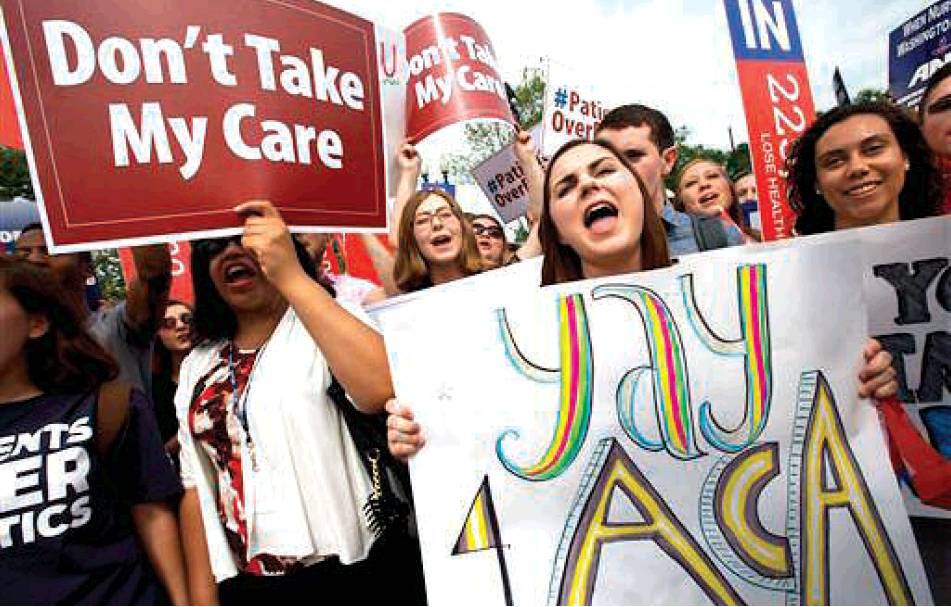In health care, ‘supply and demand’ doesn’t benefit ‘the little people’
By Roberto P. Treviño FOR THE EXPRESS-NEWS
Since President Donald Trump took office, the GOP House and Senate have each tried to repeal and replace the Affordable Care Act — without success — not to mention the 62 times the GOP tried and failed when Barack Obama was president.
One item that is consistent in all their efforts is their contention that whatever replaces the ACA has to be oriented to the free market.
This is where the square gets stuck in the circle.
In the free market economy, products and services are supplied by producers and professionals based on demand by the consumer. The supply is driven by the quantity of products and services available, and the price the consumer is willing to pay.
For example, if a manufacturer only produced 10 shirts for $10 each but 20 consumers want the shirts, the manufacturer could increase the price to $15 a shirt. On the other hand, if only five consumers want the shirts, the manufacturer would lower the price to $5 a shirt. Equilibrium occurs between quantity and price. This natural phenomenon is known as the “invisible hand.”
In free markets, the economy is driven by the “little people” — the consumers. Seventy percent of all U.S. expenditures is spent by the consumer; 20 percent by government; 12 percent by businesses; and a negative 2 percent by import and exports (the U.S. imports more than it exports).
In health care, the “little people” are belittled — the “invisible hand” becomes visible, and manipulations from different sectors intervene to allocate health care services and prices.
Let’s start with the demand. Take the case of a 64-year-old male with a urinary obstruction who is covered by private health insurance. His primary care provider finds an enlarged prostate and a nodule. He will need diagnostic tests and therapeutic procedures. The consumer here is bumped to the back seat, while the primary care provider and the specialist discuss and decide on a course of action. The patient is sent home with a catheter to help drain the bladder while he waits for his health insurance plan to approve the referral to the specialist.
The second event is different for the consumer in free markets and the consumer in health care in that in the former, the consumer pays the bills and in the latter the health insurance plan foots the bill. Now, the consumer is bumped further back. The health insurance company decides that the specialist the patient was referred to is not in its plan. The health plan then redirects the patient to another specialist. This specialist has never worked with the primary care provider and does not have admitting privileges at the hospital where the primary care has other specialists caring for inpatients. To complicate things further, the health insurance plan does not have a contract with the hospital where the specialist has preferred staff and instruments to do surgery.
So the consumer is sent to another hospital. The patient has his surgery, all goes well, and he is sent home with several prescriptions.
Now let’s go to the supply side. In the free market, when there is an increase in the demand, the supply ratchets up. That is not the case in health care. Schools for nurses and doctors have such rigorous admission criteria that the supply of health professionals is clenched, causing severe shortages. According to a report by the American Association of Colleges of Nursing, 64,067 qualified applicants were turned away from nursing schools in 2016. Similarly, a 2008 report by the Association of American Medical Colleges showed that in 15 years, the U.S. will have a shortage of 159,300 physicians.
Because of highly regulated credentialing processes, state licensing boards are also constrictors in the supply of health professionals. A nurse or a physician can have a license to practice in two states but be unable to get credentialed in a third state. This is because of the many variations in interstate requisites for credentialing.
In free markets, when the demand for a product increases, the price of that product increases too. That is not the case in health care. The pharmaceutical industry is a large supplier of health care products. Daraprim, an anti-parasitic drug, shot up from $13.50 to $750 a pill; cyclosporine, an anti-tuberculosis drug, from $16.60 to $360 a pill; epinephrine, an anti-allergy medication, from $57 to $500 an injection. Many more drugs have, overnight and without an increase in demand, shot up to exorbitant levels.
In free markets where there are areas with high demand of products or services, the supply will pick up and move their operations to those areas. In health care it is the opposite. Those with the higher demand are less likely to receive their much-needed supply. In 1996, I published a paper in the Journal of Health Care for the Poor and Underserved that showed that people from a low socioeconomic status were sicker and less likely to have health insurance coverage and access to health care than their more affluent and healthier counterparts.
This improved with the ACA. According to the RAND Corp., about 17 million people have gained health insurance since the ACA took effect in 2013. Many of these newly insured were lower income and had pre-existing illnesses.
So what is the solution? The ACA.
The ACA needs some mending but not an organ transplant. It has many positive features, but two core features stand out: pay for performance and pay for prevention.
When I started my primary care practice in 1986, payments for my services were based on volume. If I saw 30 patients that day, I got reimbursed for 30 patients. With the ACA, providers are incentivized by showing that patients under their care got healthier. Providers need to submit reports to insurers showing that a certain percentage of their patients have had their blood pressure levels controlled; that a certain percentage of their patients have had their blood sugar marker (hemoglobin A1c) controlled; that a certain percentage of their patients have had their cancer screenings; and many other metrics. If providers show favorable results, insurers will incentivize them more generously for their services.
The second item that is important for public health is reimbursement for preventive services. A study in the New England Journal of Medicine showed that 91 percent of all chronic diseases are associated with unhealthy behaviors, such as eating too much sugar and fat, eating too few fruits and vegetables, sitting too much, smoking, drinking and drug addiction.
It was unheard of for insurers to reimburse providers for counseling patients on lifestyle modifications until the ACA came along. Through the ACA, a code to reimburse providers was approved so they could implement educational programs to change unhealthy behaviors with the aim of preventing or controlling obesity.
Our center, the Social and Health Research Center, has been implementing the Buena-Vida Healthy Lifestyle Advocacy program, and a new study in the America Journal of Preventive Medicine will show that clients in our program have decreased 0.104 kg of weight per session attended.
BuenaVida is pending recognition by the Centers for Disease Control and Prevention as a proven diabetes and obesity prevention program.
So health care, different from free markets, needs a visible hand to protect the consumer. That is the aim of the ACA.
Both sides of the aisle should come together and build on the foundation of the ACA. But this time, bring insurers, hospitals, pharmaceuticals, medical device manufacturers, health professionals and patients to the table.
Roberto P. Treviño is a physician and director of the Social and Health Research Center in San Antonio.




